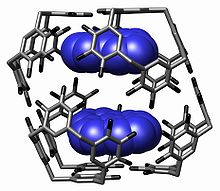
Back تجميع جزيئي فائق Arabic Υπερμοριακό συγκρότημα Greek Ensamblaje supramolecular Spanish Szupramolekuláris komplex Hungarian Assemblaggio supramolecolare Italian 超分子 Japanese Супрамолекулярная сборка Russian 超分子組裝 Chinese
| Part of a series of articles on |
| Molecular self-assembly |
|---|
 |


In chemistry, a supramolecular assembly is a complex of molecules held together by noncovalent bonds. While a supramolecular assembly can be simply composed of two molecules (e.g., a DNA double helix or an inclusion compound), or a defined number of stoichiometrically interacting molecules within a quaternary complex, it is more often used to denote larger complexes composed of indefinite numbers of molecules that form sphere-, rod-, or sheet-like species. Colloids, liquid crystals, biomolecular condensates, micelles, liposomes and biological membranes are examples of supramolecular assemblies,[3] and their realm of study is known as supramolecular chemistry. The dimensions of supramolecular assemblies can range from nanometers to micrometers. Thus they allow access to nanoscale objects using a bottom-up approach in far fewer steps than a single molecule of similar dimensions.
The process by which a supramolecular assembly forms is called molecular self-assembly. Some try to distinguish self-assembly as the process by which individual molecules form the defined aggregate. Self-organization, then, is the process by which those aggregates create higher-order structures. This can become useful when talking about liquid crystals and block copolymers.
- ^ Dalgarno, S. J.; Tucker, S. A.; Bassil, D. B.; Atwood, J. L. (2005). "Fluorescent Guest Molecules Report Ordered Inner Phase of Host Capsules in Solution". Science. 309 (5743): 2037–9. Bibcode:2005Sci...309.2037D. doi:10.1126/science.1116579. PMID 16179474. S2CID 41468421.
- ^ Hasenknopf, Bernold; Lehn, Jean-Marie; Kneisel, Boris O.; Baum, Gerhard; Fenske, Dieter (1996). "Self-Assembly of a Circular Double Helicate". Angewandte Chemie International Edition in English. 35 (16): 1838. doi:10.1002/anie.199618381.
- ^ Ariga, Katsuhiko; Hill, Jonathan P; Lee, Michael V; Vinu, Ajayan; Charvet, Richard; Acharya, Somobrata (2008). "Challenges and breakthroughs in recent research on self-assembly". Science and Technology of Advanced Materials. 9 (1): 014109. Bibcode:2008STAdM...9a4109A. doi:10.1088/1468-6996/9/1/014109. PMC 5099804. PMID 27877935.
© MMXXIII Rich X Search. We shall prevail. All rights reserved. Rich X Search